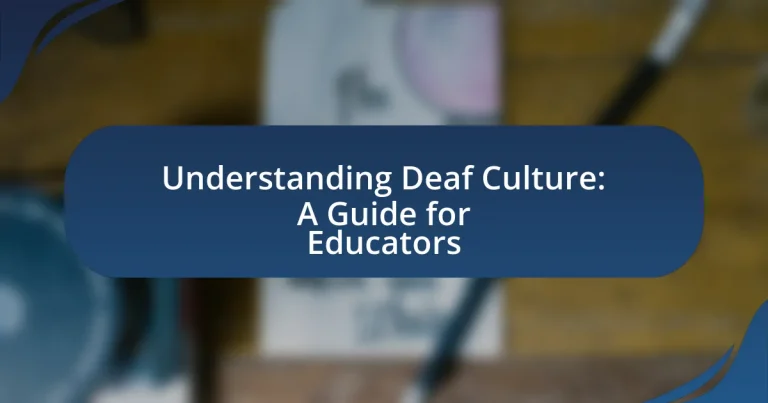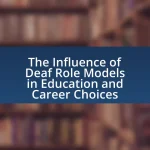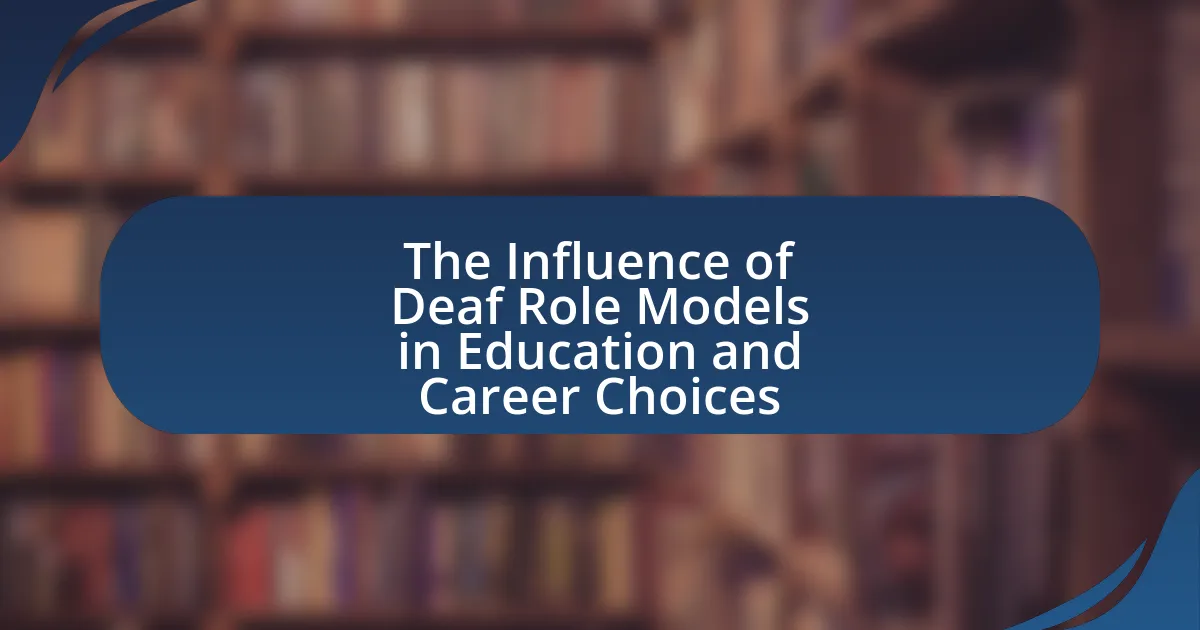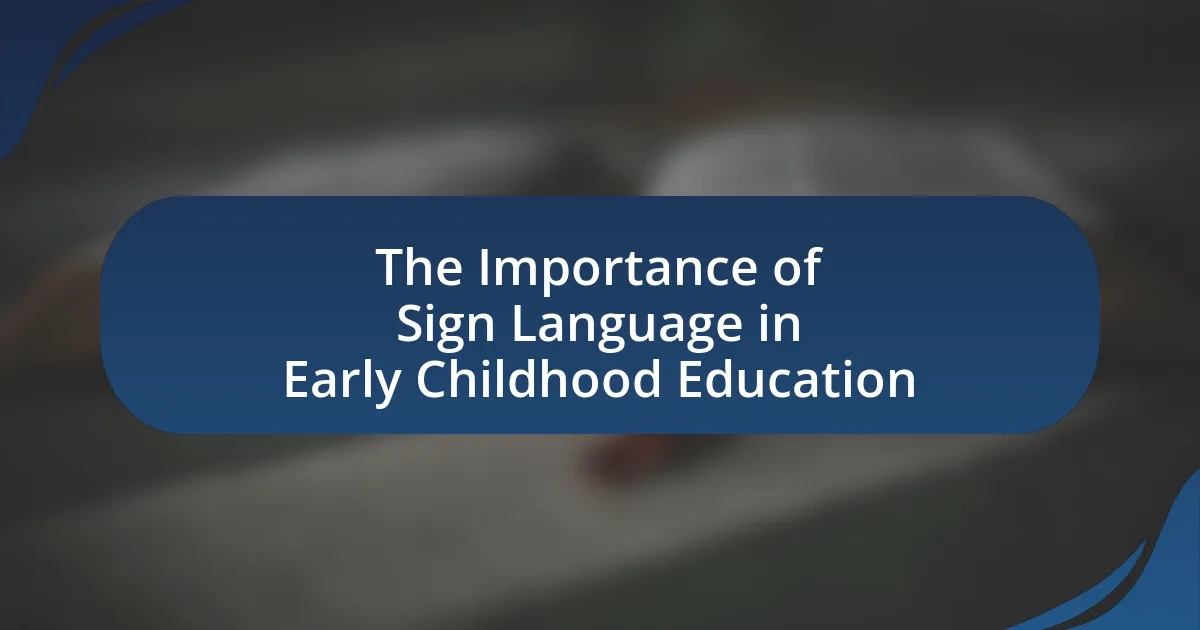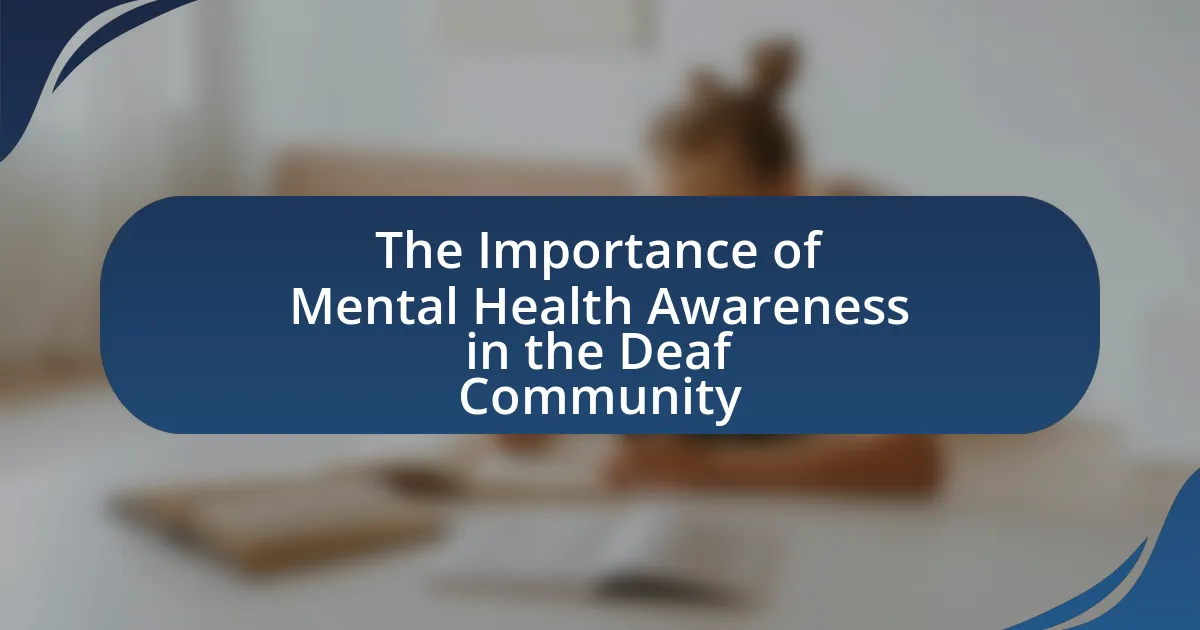Deaf culture is a distinct social and linguistic community centered around individuals who are deaf or hard of hearing, characterized by shared experiences, values, and norms primarily expressed through sign language. This article provides an overview of Deaf culture, including its definition, key characteristics, and the role of language in shaping identity. It also explores the historical evolution of Deaf culture, the challenges faced by Deaf students in education, and the importance of cultural awareness for educators. Strategies for fostering an inclusive environment and best practices for teaching Deaf students are discussed, emphasizing the significance of visual learning techniques and technology in enhancing educational outcomes.

What is Deaf Culture?
Deaf culture is a unique social and linguistic community centered around individuals who are deaf or hard of hearing, characterized by shared experiences, values, and norms. This culture is primarily expressed through sign language, which serves as a vital means of communication and identity among its members. The recognition of Deaf culture is supported by the existence of various organizations, such as the National Association of the Deaf, which advocate for the rights and recognition of deaf individuals. Additionally, research indicates that Deaf culture fosters a strong sense of belonging and community, as evidenced by the prevalence of Deaf schools and social events that celebrate shared heritage and experiences.
How is Deaf Culture defined within the community?
Deaf Culture is defined within the community as a unique social and cultural identity characterized by shared language, values, and experiences among Deaf individuals. This culture is primarily centered around American Sign Language (ASL) or other sign languages, which serve as the primary mode of communication and a key element of cultural expression. The community emphasizes the importance of visual communication, social interaction, and a collective history that distinguishes Deaf individuals from hearing individuals. Research indicates that Deaf Culture fosters a sense of belonging and pride, as evidenced by the establishment of Deaf schools, organizations, and events that celebrate Deaf identity and heritage.
What are the key characteristics of Deaf Culture?
Deaf Culture is characterized by a shared language, community values, and unique social norms. The primary language of Deaf Culture is sign language, which serves as a crucial means of communication and identity among Deaf individuals. Community values emphasize inclusivity, mutual support, and the importance of social gatherings, such as Deaf clubs and events, which foster a sense of belonging. Additionally, Deaf Culture has distinct social norms, including visual communication styles and the use of eye contact, which are essential for effective interaction. These characteristics collectively contribute to a rich cultural identity that is recognized and celebrated within the Deaf community.
How does language play a role in Deaf Culture?
Language is fundamental to Deaf Culture as it serves as the primary means of communication and identity among Deaf individuals. Sign languages, such as American Sign Language (ASL), are not merely gestures but fully developed languages with their own grammar and syntax, enabling rich expression and cultural transmission. Research indicates that sign language fosters a sense of community and belonging, as it encapsulates shared experiences and values unique to Deaf individuals. For instance, studies show that Deaf children who learn sign language early exhibit better cognitive and social development compared to those who do not. Thus, language is not only a tool for communication but also a cornerstone of cultural identity within the Deaf community.
Why is understanding Deaf Culture important for educators?
Understanding Deaf Culture is crucial for educators because it fosters effective communication and inclusivity in the classroom. Educators who comprehend the values, norms, and communication styles of Deaf individuals can create a supportive learning environment that respects and acknowledges the unique experiences of Deaf students. Research indicates that when educators are knowledgeable about Deaf Culture, they can better address the specific educational needs of Deaf students, leading to improved academic outcomes and social integration. For instance, studies show that Deaf students perform better academically when their educators are trained in Deaf Culture and sign language, as this enhances engagement and reduces feelings of isolation.
What impact does cultural awareness have on teaching practices?
Cultural awareness significantly enhances teaching practices by fostering an inclusive environment that respects and values diverse backgrounds. Educators who understand cultural nuances can tailor their instructional strategies to meet the unique needs of students, particularly in contexts like Deaf culture, where communication styles and social norms differ. Research indicates that culturally responsive teaching improves student engagement and academic performance, as it allows educators to connect learning material to students’ lived experiences. For instance, a study by Gay (2010) in “Culturally Responsive Teaching: Theory, Research, and Practice” highlights that students from diverse backgrounds perform better when their cultural identities are acknowledged and integrated into the curriculum.
How can educators foster an inclusive environment for Deaf students?
Educators can foster an inclusive environment for Deaf students by implementing visual learning strategies and promoting sign language use in the classroom. Research indicates that incorporating visual aids, such as images, videos, and diagrams, enhances comprehension for Deaf learners, as they often rely on visual information. Additionally, encouraging the use of sign language not only facilitates communication but also validates Deaf culture, creating a sense of belonging. Studies show that classrooms where sign language is integrated see improved social interactions and academic performance among Deaf students, reinforcing the importance of an inclusive approach.
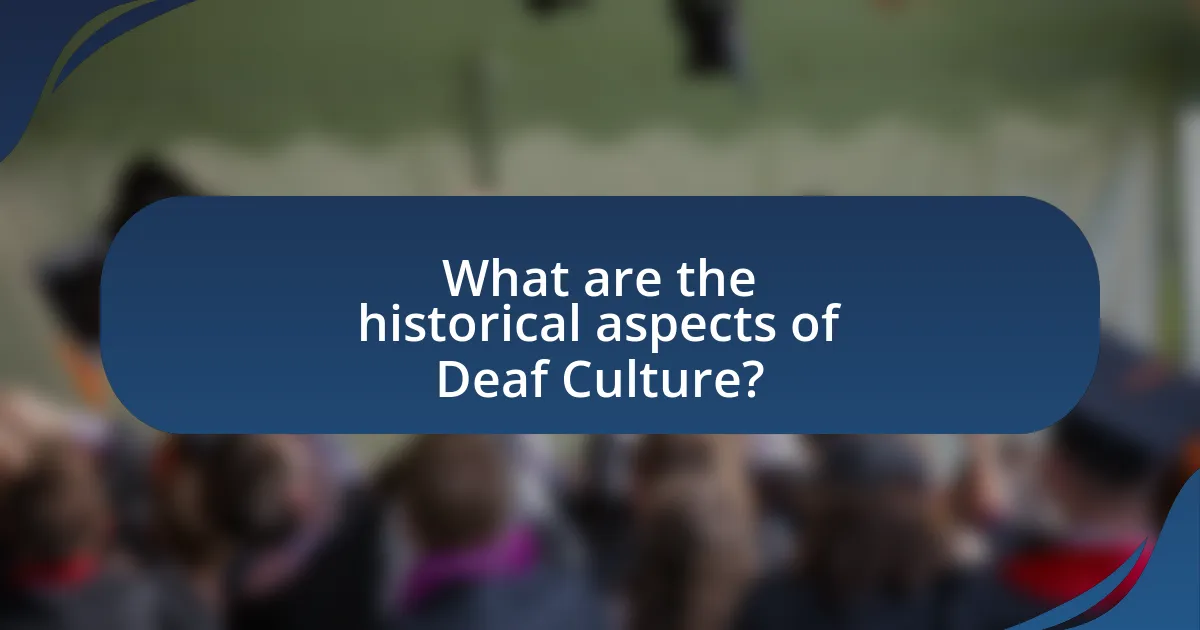
What are the historical aspects of Deaf Culture?
The historical aspects of Deaf Culture include the establishment of formal education for the Deaf, the development of sign languages, and the formation of Deaf communities. In the early 19th century, the founding of the first school for the Deaf in the United States, the American School for the Deaf in Hartford, Connecticut, in 1817, marked a significant milestone in Deaf education. This institution was pivotal in promoting American Sign Language (ASL) as a legitimate language. Additionally, the Milan Conference of 1880, which favored oralism over sign language, significantly impacted Deaf education and culture, leading to a decline in the use of sign languages in many educational settings. The rise of Deaf advocacy movements in the late 20th century, particularly the Deaf President Now movement in 1988 at Gallaudet University, further solidified Deaf Culture as a distinct identity, emphasizing pride in Deaf heritage and the importance of sign language. These historical events illustrate the evolution and resilience of Deaf Culture throughout the years.
How has Deaf Culture evolved over time?
Deaf Culture has evolved significantly over time, transitioning from a marginalized community to a recognized cultural identity. Historically, Deaf individuals faced oppression and were often denied access to education and social integration, leading to the establishment of Deaf schools in the 19th century, such as the American School for the Deaf in 1817, which fostered a sense of community and shared language. The introduction of American Sign Language (ASL) as a legitimate language in the 1960s further solidified Deaf Culture, promoting pride and identity among Deaf individuals. The rise of advocacy movements in the late 20th century, such as the Deaf President Now movement in 1988, highlighted the demand for representation and rights, further shaping the cultural landscape. Today, Deaf Culture is characterized by its unique language, art, and social norms, reflecting a rich heritage that continues to evolve with technological advancements and increased visibility in society.
What significant events have shaped Deaf Culture?
Significant events that have shaped Deaf Culture include the establishment of the first formal school for the deaf in 1817, the founding of Gallaudet University in 1864, and the Milan Conference of 1880, which promoted oralism over sign language. The establishment of the first school for the deaf in Hartford, Connecticut, marked a pivotal moment in providing education and community for Deaf individuals. Gallaudet University, the first institution of higher education for the deaf, further solidified the importance of Deaf identity and culture. The Milan Conference, however, had a detrimental impact by advocating for oralism, leading to a decline in the use of sign language and affecting Deaf education for decades. These events collectively influenced the development, preservation, and evolution of Deaf Culture.
How do historical perspectives influence current Deaf identity?
Historical perspectives significantly shape current Deaf identity by providing a framework through which Deaf individuals understand their cultural heritage and social experiences. The historical oppression faced by Deaf communities, such as the oralist movement in the late 19th and early 20th centuries, which prioritized spoken language over sign language, has led to a strong sense of cultural pride and resistance among Deaf individuals today. This historical context fosters a collective identity that emphasizes the importance of sign language and Deaf culture, as evidenced by the establishment of Deaf schools and organizations that promote advocacy and community. Furthermore, the recognition of American Sign Language (ASL) as a legitimate language in the 1960s has reinforced the value of Deaf identity, allowing for a more cohesive community that celebrates its unique linguistic and cultural attributes.
Why is the history of Deaf Culture relevant to education?
The history of Deaf Culture is relevant to education because it provides essential context for understanding the unique linguistic, social, and cultural experiences of Deaf individuals. This historical perspective informs educators about the evolution of sign language, the impact of educational policies, and the significance of community identity among Deaf people. For instance, the establishment of American Sign Language (ASL) in the 19th century and the subsequent recognition of Deaf culture as a legitimate linguistic and cultural entity highlight the importance of inclusive teaching practices. Understanding these historical milestones enables educators to create more effective and culturally responsive learning environments that respect and affirm Deaf students’ identities and experiences.
What lessons can educators learn from the history of Deaf Culture?
Educators can learn the importance of valuing diverse communication methods from the history of Deaf Culture. The evolution of Deaf Culture highlights the significance of American Sign Language (ASL) as a legitimate language, which emphasizes the need for educators to recognize and incorporate various forms of communication in their teaching practices. Historical events, such as the establishment of Gallaudet University in 1864, demonstrate the community’s advocacy for educational access and the promotion of Deaf identity. This history underscores the necessity for educators to create inclusive environments that respect and celebrate linguistic diversity, fostering a sense of belonging among Deaf students.
How can historical context inform teaching strategies?
Historical context can inform teaching strategies by providing educators with insights into the cultural, social, and political factors that have shaped the experiences of Deaf individuals. Understanding the historical marginalization and advocacy movements within Deaf culture, such as the establishment of American Sign Language and the impact of the Milan Conference of 1880, allows educators to create inclusive curricula that respect and reflect Deaf identities. This contextual knowledge enables teachers to adopt strategies that promote equity, such as incorporating Deaf history into lessons and using culturally relevant materials, thereby fostering a more supportive learning environment for Deaf students.
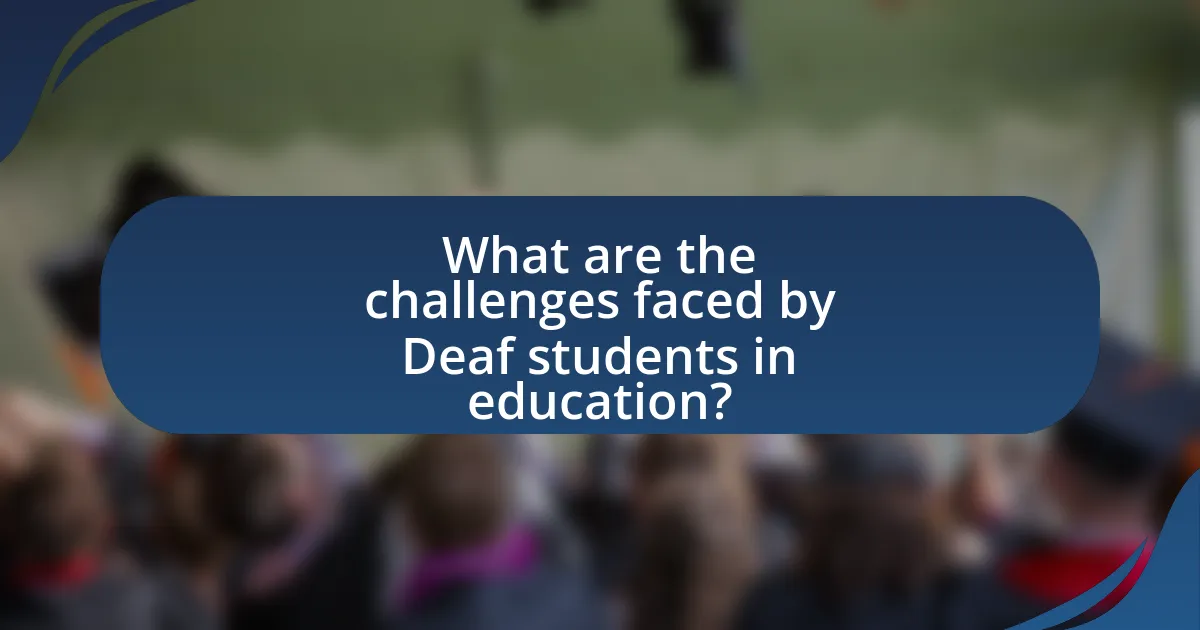
What are the challenges faced by Deaf students in education?
Deaf students face significant challenges in education, primarily due to communication barriers, lack of access to resources, and social isolation. Communication barriers arise when educators and peers are not proficient in sign language, leading to misunderstandings and limited participation in classroom discussions. A study by the National Deaf Center on Postsecondary Outcomes indicates that only 36% of Deaf students report having access to qualified interpreters, which directly impacts their learning experience. Additionally, the lack of tailored educational resources, such as visual aids and technology designed for Deaf learners, further hinders their academic progress. Social isolation is another critical challenge, as Deaf students often struggle to connect with hearing peers, resulting in feelings of loneliness and exclusion. This isolation can negatively affect their mental health and overall educational engagement.
What barriers do Deaf students encounter in mainstream classrooms?
Deaf students encounter several barriers in mainstream classrooms, primarily including communication challenges, social isolation, and inadequate support services. Communication barriers arise from the reliance on spoken language in instruction, which can hinder Deaf students’ understanding and participation. Social isolation often occurs due to difficulties in interacting with hearing peers, leading to feelings of exclusion. Additionally, inadequate support services, such as insufficient access to interpreters or specialized teaching methods, further impede their educational experience. Research indicates that these barriers can significantly affect academic performance and social development, highlighting the need for tailored educational strategies to support Deaf students effectively.
How do communication barriers affect learning outcomes?
Communication barriers significantly hinder learning outcomes by obstructing the exchange of information between educators and students. When communication is ineffective, students may struggle to grasp concepts, leading to decreased comprehension and retention of material. Research indicates that students with hearing impairments, for instance, often experience lower academic performance due to inadequate access to spoken language and instructional content. A study published in the Journal of Deaf Studies and Deaf Education found that effective communication strategies, such as the use of sign language and visual aids, can enhance learning outcomes for deaf students by facilitating better understanding and engagement. Thus, addressing communication barriers is crucial for improving educational success among diverse learners.
What social challenges do Deaf students face among peers?
Deaf students face significant social challenges among peers, primarily due to communication barriers and social isolation. These barriers often lead to misunderstandings and exclusion from group activities, as hearing peers may struggle to engage effectively with Deaf students. Research indicates that Deaf students frequently report feelings of loneliness and difficulty forming friendships, which can be attributed to a lack of shared communication methods and cultural understanding. For instance, a study published in the Journal of Deaf Studies and Deaf Education highlights that Deaf students are less likely to be invited to social gatherings, further exacerbating their sense of isolation.
How can educators address these challenges effectively?
Educators can effectively address challenges related to understanding Deaf culture by implementing inclusive teaching strategies and fostering a supportive learning environment. This includes utilizing sign language as a primary mode of communication, incorporating Deaf culture into the curriculum, and providing professional development for staff on Deaf awareness. Research indicates that when educators engage with Deaf culture and language, students experience improved academic outcomes and social integration (Ladd, P. 2003, “Understanding Deaf Culture: In Search of Deafhood,” Multilingual Matters). By actively promoting an inclusive atmosphere, educators can enhance the educational experience for Deaf students and bridge communication gaps.
What strategies can be implemented to support Deaf students?
To support Deaf students, educators can implement strategies such as using visual aids, incorporating sign language, and fostering an inclusive classroom environment. Visual aids, including charts and videos, enhance comprehension by providing context and clarity. Incorporating sign language as a primary mode of communication facilitates better interaction and understanding among Deaf students and their peers. Additionally, fostering an inclusive environment that encourages collaboration and respect for Deaf culture promotes social integration and emotional well-being. Research indicates that these strategies significantly improve academic performance and social skills in Deaf students, as evidenced by studies showing higher engagement levels in classrooms that utilize these methods.
How can collaboration with Deaf community members enhance education?
Collaboration with Deaf community members enhances education by integrating diverse perspectives and fostering inclusive learning environments. Engaging Deaf individuals in educational settings allows for the incorporation of sign language and Deaf culture, which can improve communication and understanding among all students. Research indicates that when educators collaborate with Deaf community members, it leads to better academic outcomes and social integration for Deaf students, as evidenced by studies showing that inclusive practices increase participation and engagement in classroom activities.
What best practices should educators adopt when teaching Deaf students?
Educators should adopt inclusive communication strategies, such as using sign language and visual aids, when teaching Deaf students. Research indicates that Deaf students benefit significantly from instruction that incorporates American Sign Language (ASL) or other sign languages, as it enhances their understanding and engagement. Additionally, creating a visually rich learning environment, utilizing captions for videos, and ensuring clear visibility of the instructor’s face for lip-reading are essential practices. Studies show that these methods improve comprehension and retention of information among Deaf learners, fostering a more effective educational experience.
How can educators incorporate visual learning techniques?
Educators can incorporate visual learning techniques by utilizing visual aids such as diagrams, charts, and videos to enhance comprehension. Research indicates that visual learning can significantly improve retention and understanding, particularly for students who are deaf or hard of hearing. For instance, studies show that using visual representations alongside verbal instructions can lead to a 50% increase in information retention among these learners. Additionally, incorporating sign language and visual storytelling can further engage students and facilitate a deeper understanding of the material.
What role does technology play in supporting Deaf education?
Technology plays a crucial role in supporting Deaf education by enhancing communication, accessibility, and learning opportunities. Tools such as video relay services, captioning software, and specialized educational apps facilitate real-time communication between Deaf students and educators, breaking down barriers that traditional methods may impose. For instance, research indicates that the use of video conferencing technology allows Deaf students to engage in interactive learning experiences, which can improve their academic performance and social skills. Additionally, assistive technologies like hearing aids and cochlear implants provide auditory access, while visual learning tools cater to the unique learning styles of Deaf individuals. These advancements collectively contribute to a more inclusive educational environment, ensuring that Deaf students receive equitable access to quality education.
